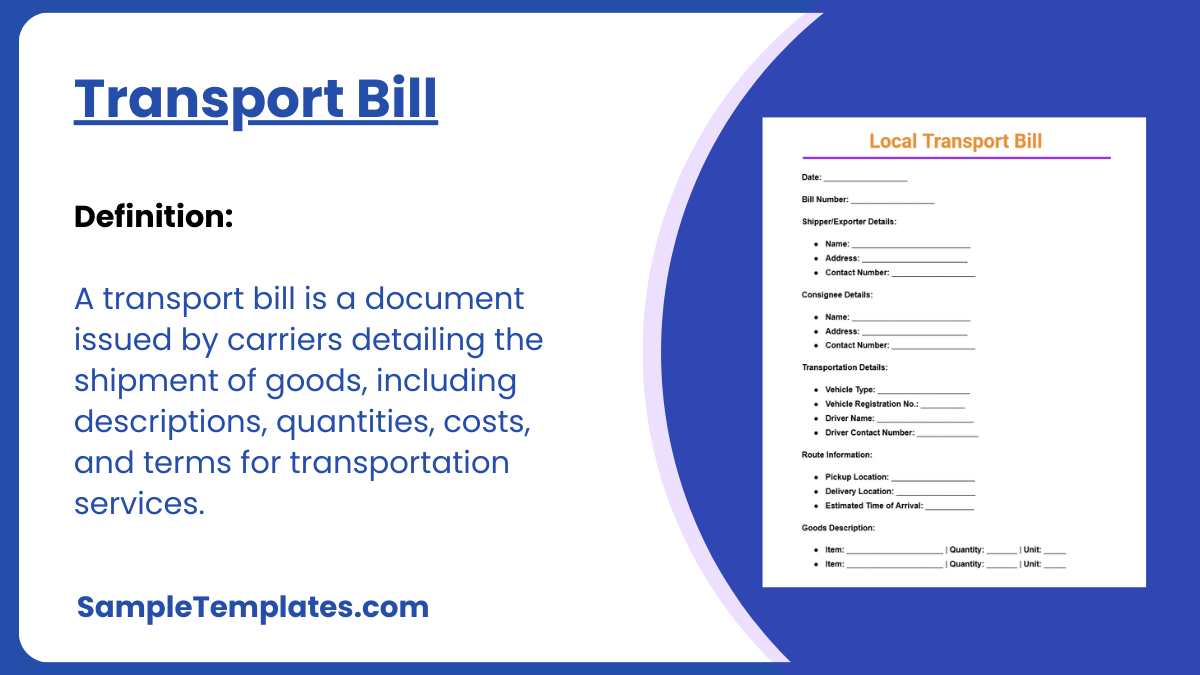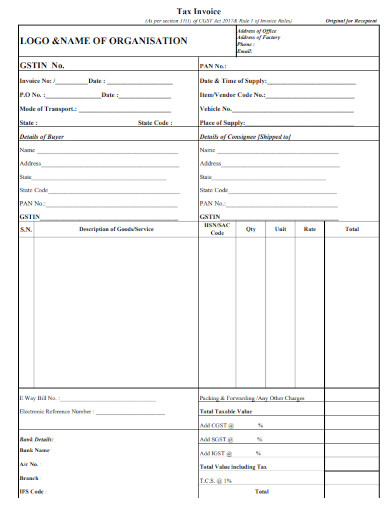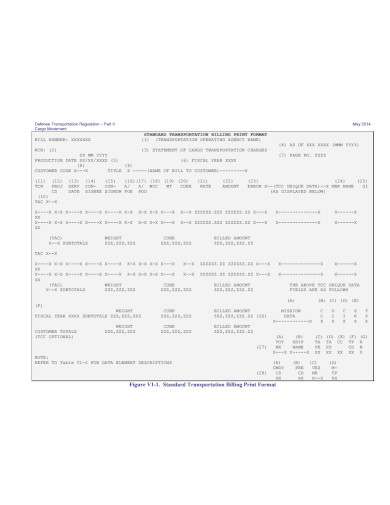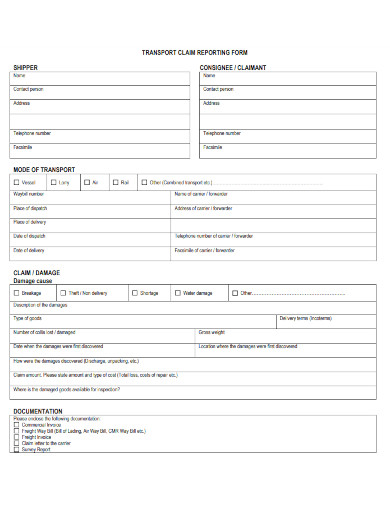These days, there are enterprises in a wide array of commercial industries. You can find recruitment agencies, furniture companies, pharmaceutical brands, food suppliers, and clothing stores, just to name a few. When talking about transportation services, you can choose from all kinds of businesses for your needs. Some service examples include but are not limited to luggage storage, freight logistics, household relocation, and parcel delivery. If you run such an enterprise, your operations need many essential tools, like a transport bill format. By incorporating an official transport service bill or invoice, you can provide clients with the necessary information about their due fees.

Download Transport Bill Bundle
Transport Bill of Lading
Shipper/Exporter:
Name: ___________________________
Address: _________________________
City/State/Zip: ___________________
Country: _________________________
Consignee:
Name: ___________________________
Address: _________________________
City/State/Zip: ___________________
Country: _________________________
Carrier Name: ___________________
Agent (if applicable): ______________
Point of Origin: ___________________
Final Destination: __________________
Route (if applicable):
Transportation Mode (e.g., Road, Rail, Air, Sea): __________
Vehicle/Flight/Vessel No.: ______________
Date of Shipment: ___________________
Expected Delivery Date: ______________
Description of Goods:
- ______________ | Qty: ______ | Weight: ______
- ______________ | Qty: ______ | Weight: ______
- ______________ | Qty: ______ | Weight: ______
Special Handling Instructions:
Declared Value of Cargo: $____________
Freight Charges:
Prepaid: _____ Collect: _____ Third Party: _____
Bill of Lading Number: _______________
Shipment Reference Number: __________
Signatures:
Shipper: _____________________________
Carrier: ______________________________
Receiver (Consignee): ___________________
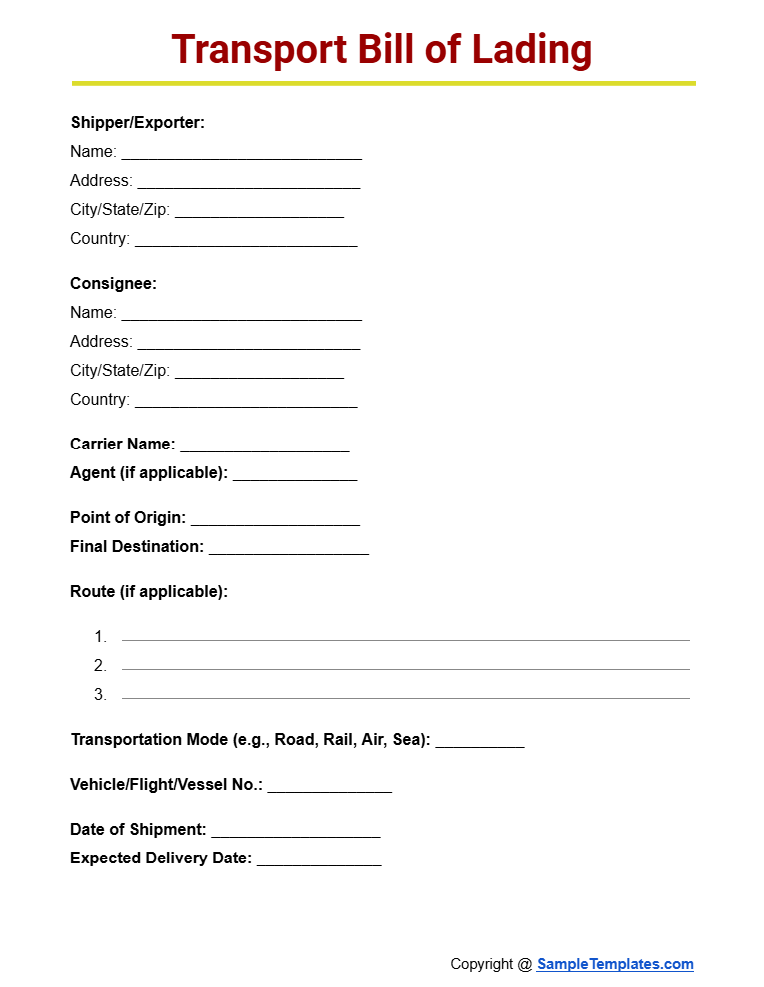
Local Transport Bill
Date: ___________________
Bill Number: ___________________
Shipper/Exporter Details:
- Name: ___________________________
- Address: ________________________
- Contact Number: ___________________
Consignee Details:
- Name: ___________________________
- Address: ________________________
- Contact Number: ___________________
Transportation Details:
- Vehicle Type: _____________________
- Vehicle Registration No.: __________
- Driver Name: ______________________
- Driver Contact Number: ______________
Route Information:
- Pickup Location: ___________________
- Delivery Location: __________________
- Estimated Time of Arrival: ___________
Goods Description:
- Item: ______________________ | Quantity: _______ | Unit: _____
- Item: ______________________ | Quantity: _______ | Unit: _____
- Item: ______________________ | Quantity: _______ | Unit: _____
Special Instructions:
Charges:
- Transport Fee: $__________
- Additional Charges: $__________
- Total Amount: $__________
Payment Details:
- Payment Method: ___________________
- Payment Terms: ____________________
Signatures:
- Authorized Shipper Signature: __________________
- Driver Signature: __________________
- Consignee Signature upon Delivery: __________________
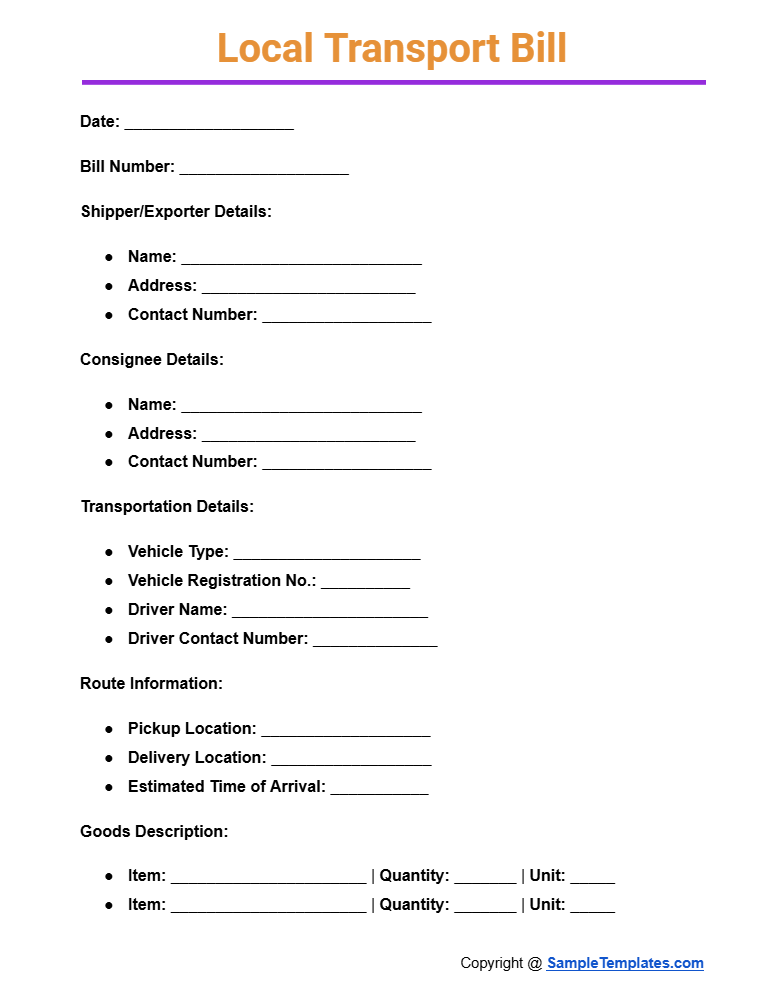
Vehicle Bill of Lading
Date: ___________________
Bill of Lading Number: ___________________
Shipper/Exporter:
Name: ___________________________
Address: _________________________
Phone: ___________________________
Email: ___________________________
Consignee:
Name: ___________________________
Address: _________________________
Phone: ___________________________
Email: ___________________________
Origin of Shipment: ___________________
Destination: ___________________
Carrier Information:
Name: ___________________________
Driver’s Name: ___________________
Vehicle Reg. No.: _________________
Trailer No.: _____________________
Vehicle Details:
- Make and Model: ________________________
- Year: ________________________
- Color: ________________________
- VIN (Vehicle Identification Number): ________________________
- Odometer Reading: __________________ km/miles
Vehicle Condition Report:
Check and note any damage or marks before shipping.
- Front Bumper: __________________
- Rear Bumper: __________________
- Left Side: __________________
- Right Side: __________________
- Windshield: __________________
- Roof: __________________
Additional Contents (if any):
List any personal items left in vehicle:
- Item 1: ________________________
- Item 2: ________________________
- Etc.
Special Handling Instructions:
Shipping Terms and Conditions:
- Freight Charges: Prepaid / Collect (Circle one)
- Declared Value of Vehicle: $_______________
- Insurance (if applicable): ___________________
Signatures:
- Shipper Signature: _____________________________
- Carrier Driver Signature: _______________________
- Consignee Signature on Delivery: ___________________
Remarks:

Browse More Templates On Transport Bill
1. Transport Bill Invoice Format
How to Make a Transport Bill?
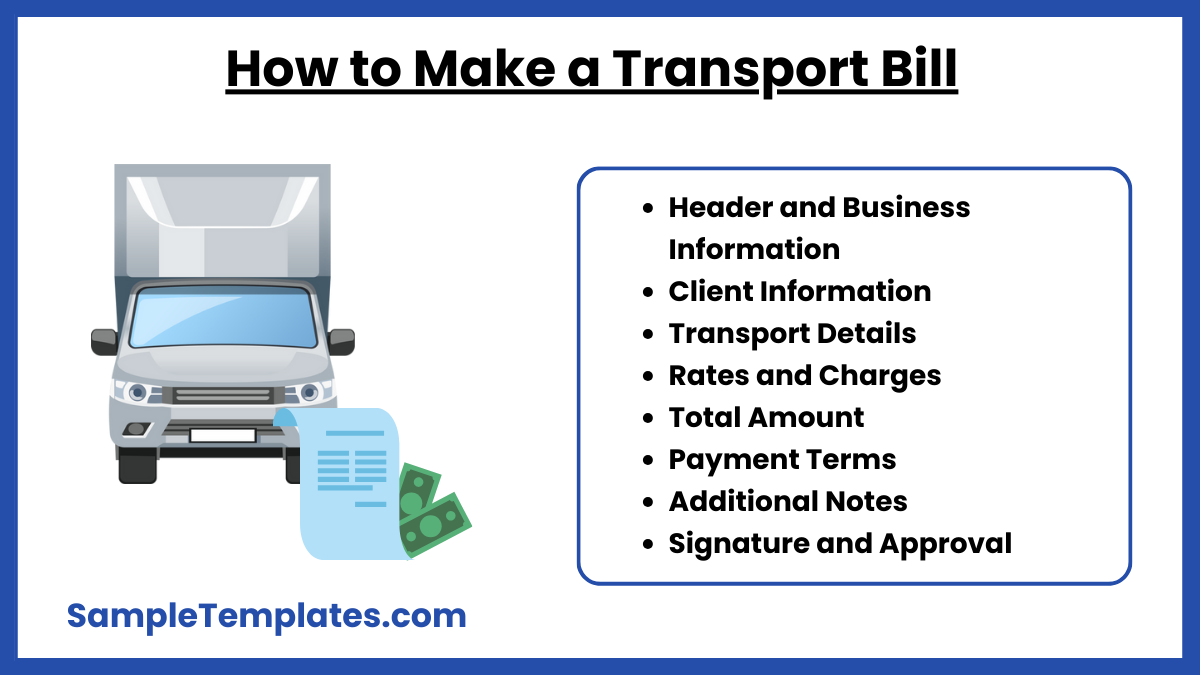
- Header and Business Information: Include your company’s name, logo, address, and contact details at the top. Add the date and bill number for tracking. You can also see more on Travel Bill.
- Client Information: List the recipient’s business name, contact information, and address.
- Transport Details: Provide a detailed description of the transport service, including pickup and delivery locations, dates, and the type of goods transported.
- Rates and Charges: Include the rate per mile, weight, or other unit of measure. Specify additional fees like fuel surcharges or handling fees.
- Total Amount: Clearly state the subtotal, any applicable taxes, and the final total amount due.
- Payment Terms: Mention the payment terms, due date, and acceptable payment methods (e.g., bank transfer, check, credit card). You can also see more on Mobile Bill.
- Additional Notes: Include any additional information, such as liability disclaimers, late fees, or special conditions related to the transport service.
- Signature and Approval: Provide space for the client’s signature and date, confirming their agreement with the charges listed.
2. Standard Transportation Billing Format
Purpose of Transport Bill
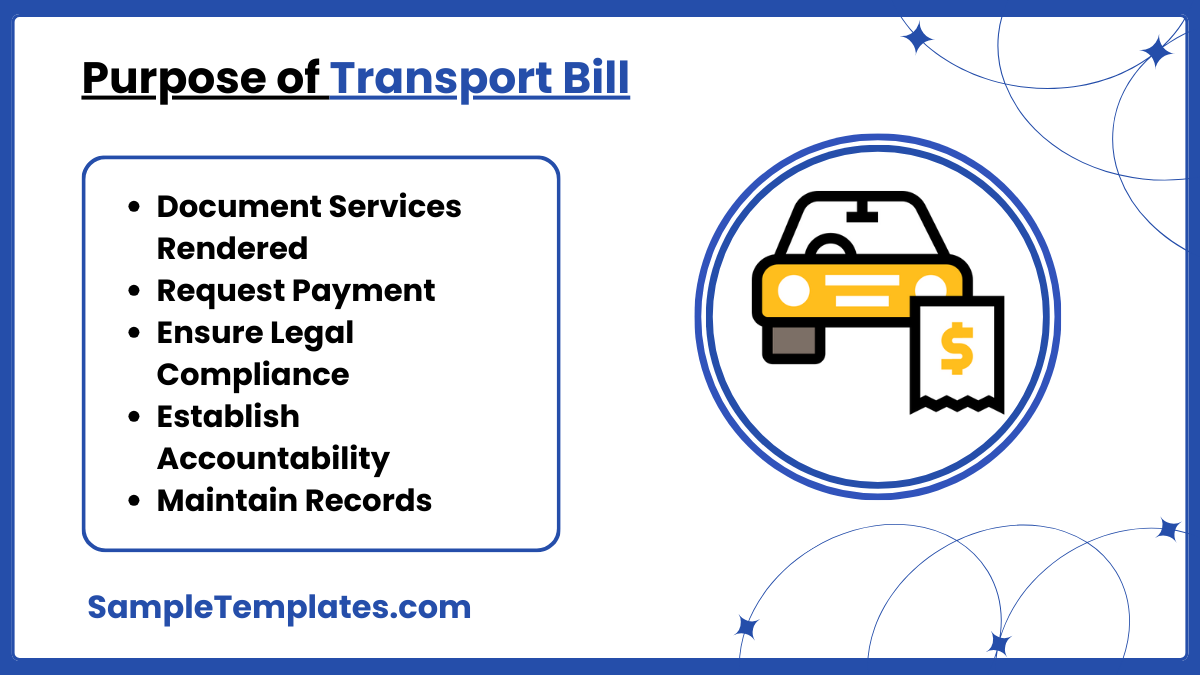
- Document Services Rendered: Provide a detailed record of the transportation services provided, including distance, weight, and delivery details. You can also see more on Brokerage Bill.
- Request Payment: Formally request payment for transport services, outlining the rates, fees, and total amount due.
- Ensure Legal Compliance: Serve as an official document for tax and regulatory compliance, showing proof of transactions.
- Establish Accountability: Hold both parties accountable by providing a clear summary of the agreed-upon services and charges.
- Maintain Records: Create an accurate record for both the transporter and client for bookkeeping, audits, and future reference. You can also see more on Bill Format.
3. Consumer Electric Bill Format
Benefits of Transport Bill
- Clear Payment Request: It provides a detailed breakdown of services and charges, ensuring transparency in payment. You can also see more on Travel Invoice.
- Legal Proof: Serves as a legal document for both parties, protecting against disputes regarding services or payments.
- Record Keeping: Maintains accurate financial records for accounting, tax filing, and future audits.
- Improves Accountability: Ensures that the transporter and client are on the same page regarding the scope and cost of the transport services.
- Ensures Timely Payments: By clearly stating payment terms and deadlines, it helps facilitate prompt payments. You can also see more on Transport Service Proposal.
- Professionalism: Enhances the business image by presenting a formal and structured billing process.
- Regulatory Compliance: Helps businesses comply with tax and regulatory requirements by providing an official document of the transaction.
- Facilitates Dispute Resolution: A well-detailed bill can resolve potential disputes over service delivery and costs.
4. Transport Claim Bill Reporting Format
What Is a Transport Bill?
When running a transportation business, there’s a wide array of tools and documents for your tasks. There are mind maps, strategy maps, waterfall charts, Gantt charts, HR dashboards, and much more for your service-oriented company. With a transport bill format, you can request due payment from clients in a quick and efficient process. A billing document outlines multiple details about the provided transportation services, the owed payment amount, and business information. You can submit a transport bill through a physical letter or an email document, making it versatile in use. Whether you run a taxi company, airline business, food delivery, or shipping service, a transport bill is essential to your overall operations. Are you looking to expedite your bill composition process with minimal hassle? If so, feel free to read our tips for convenience.
Types of Bills of Lading
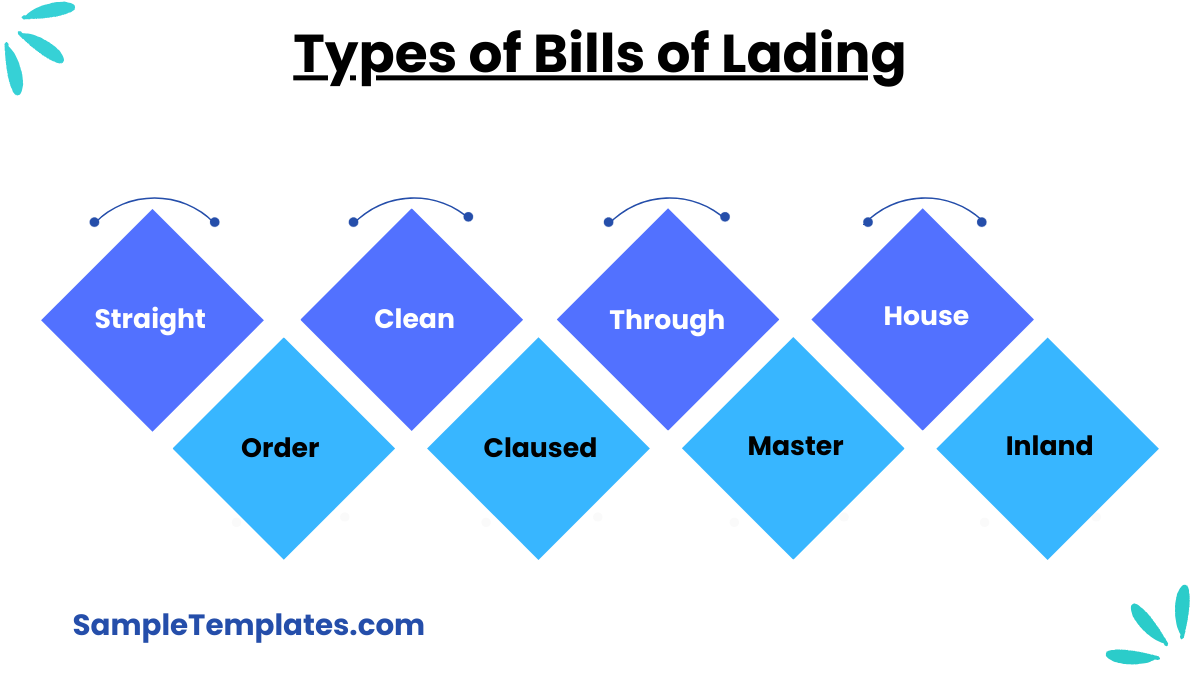
- Straight Bill of Lading: A non-negotiable document where the goods are consigned to a specific recipient, typically used for domestic shipments or transactions where payment has been made in advance. You can also see more on Delivery Invoice.
- Order Bill of Lading: A negotiable document that allows the transfer of goods to a third party by endorsement, commonly used in international trade to secure payment before goods are delivered.
- Clean Bill of Lading: Issued when goods are received in good condition without any damage or discrepancies, ensuring that the carrier is responsible for delivering the goods as described.
- Claused (Foul) Bill of Lading: Contains a note of damage or missing items at the time of loading, indicating that the goods may not have been in good condition when received by the carrier. You can also see more on Bill of Material.
- Through Bill of Lading: Covers the transport of goods across different carriers and modes of transportation, from origin to final destination, facilitating international shipping.
- Master Bill of Lading: Issued by the main carrier (shipping line), it details the terms of carriage between the shipper and the main carrier.
- House Bill of Lading: Issued by a freight forwarder or non-vessel operating common carrier (NVOCC), it represents a contract of carriage between the shipper and the freight forwarder.
- Inland Bill of Lading: Used for the transport of goods via land (rail or road) before or after they reach a port for sea transport. You can also see more on Bill of Sale.
FAQs
What is a bill of lading?
A bill of lading (BoL) acts as a receipt and contract handed to a client upon meeting by a driver picking up a vehicle for transport. You can also see more on
Who should issue a bill of lading?
A freight forwarder or non-vessel operating common carrier (NVOCC) issues the bill of lading as the seller or exporter.
What are some examples of a bill of lading?
A few examples are house bill of lading, master bill of lading, container bill of lading, and bearer bill of lading.
Whether your transportation enterprise operates by road, air, or sea, incorporating a bill format document is vital to operations. So, download a PDF sample now to expedite your transport bill efficiently.
Related Posts
Distributor Letter of Appointment
Disciplinary Meeting Minutes
Service Quote
Payment Voucher
Quantitative Problem Statement
Furniture Company Profile
Travel Quotation
Catering Company Profile
Product Proposal Letter
Excel Ledger
Enquiry Form
Reservation Letter
Payment Request Form
One Point Lesson
Quotation Letter
